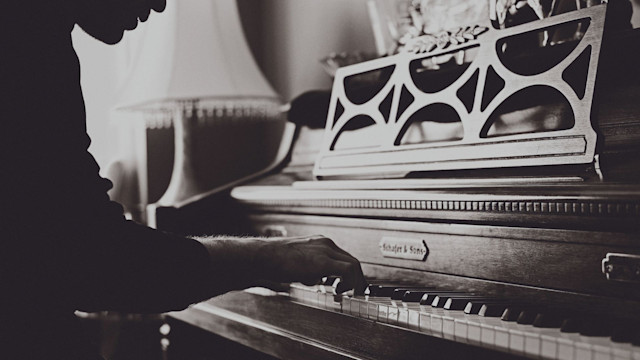Sad Chord Progressions: Emotional & Beautiful Chords
October 16, 2024 - Discover how sad chord progressions can bring depth and emotion to your music, enhancing your songwriting with beautiful, melancholic harmonies and structures.

Only a few things in music can stir the heart like a well-crafted sad chord progression. There are sequences of chords that can evoke a deep sense of melancholy and introspection, resonating with our own emotional experiences.
Sad chord progressions consist mostly of minor chords, clusters, and sometimes unresolved chords to create an evocative sound.
Whether you're composing a somber ballad or want to add an emotional layer to your piece of music, understanding these progressions is key to capturing the mood.
Incorporating some of these common chord progressions into your music gives you a powerful storytelling tool that enriches the narrative of your compositions and amplifies the feelings you want to convey.
Understanding Sad Chord Progressions
Before we cover my favorite sad chord progressions, let's go over some basic music theory on chords so you can effectively use them in your music.
Building Blocks of Chord Progressions
Chord progressions are sequences of chords that provide harmony in music.
The major and minor chords form the foundation. For example, a chord progression in the key of C major might involve the chords C (I), F (IV), and G (V).
Roman numerals are often used to denote chord positions in the minor or major scale in the key of the composition. This systematic approach facilitates easy transposition to other keys.
Using these structures, you can experiment with different chords and create progressions like C-G-Am-F, a popular sequence known for its familiar sound and emotional impact.
The Role of Major and Minor Triads
Major and minor triads are fundamental in music theory.
A major triad consists of a root, major third, and perfect fifth, while a minor triad has a root, minor third, and perfect fifth.
For instance, the D minor (Dm) and E minor (Em) chords are part of the minor scale family and can bring a sad or reflective mood to your music. In contrast, major chords like G major provide a happy, uplifting feel.
Combining these triads allows for versatile expressions, balancing between emotions by strategically shifting between major and minor tonalities.
Diatonic Chords and the Circle of Fifths
Diatonic chords are derived from the tones of major or minor scales. They consist of chords built from each scale degree, bringing cohesion to progressions. In the key of C major, the diatonic chords include C, Dm, Em, F, G, Am, and Bdim.
The Circle of Fifths is a visual representation of the relationship between keys. It helps identify which chords belong together, assisting in crafting seamless transitions. This tool can create fluid progressions across the musical spectrum.
Incorporating these concepts into your composing can deepen your musical storytelling, harnessing the power of chord progressions to create the desired emotional effect.
My Top 10 Favorite Sad Chord Progressions
1. VI – iv – i – v
This progression stands out with its use of the iv chord, lending it a somber, reflective atmosphere. It’s perfect for creating a haunting mood, with the minor chords adding emotional depth and a sense of darkness.
2. i – VI – III – VII
A grand and expressive progression, this one builds sadness through its rise from minor to major chords before descending back, offering a melancholic, bittersweet sound.
3. VI – VII – i – v
This is a great progression that has a rising quality, adding a sense of hopeful sorrow. The contrast between the VI and minor v chords creates an emotional push and pull, making it perfect for songs about regret.
4. VI – VII – v – i
This one adds a bit of delayed tension before resolving back to the minor i. It’s particularly effective for creating a deep, reflective sadness while feeling like it needs to continue moving forward.
5. i – III – VII – VI
Starting in the minor and landing on a VI chord, this progression gives a feeling of incompleteness. It’s great for evoking unresolved emotions and perfect for lyrics about loss or nostalgia. Definitely another one of my favorites that gives you a different way to hold the tension.
6. i – VI – VII – v
This classic sad progression, with a delicate sense of longing, makes it great for both intimate slow tempo ballads and dramatic, sorrow-filled moments. The descending pattern pulls at the heartstrings.
7. VI – VII – III – VI
With a repeated VI chord adding weight to this progression, it lends a heavy, almost desperate emotional quality to the music, making it great for intense, vocal-driven tracks.
8. i – VII – VI – VII
This progression features a descending motion before resolving to the i chord, creating a cyclical feeling of melancholy. The subtle shifts evoke a sense of isolation or distance. It's just a simple choice of chords, yet so effective, and it lays out the perfect foundation for a sad storyline and melody.
9. VI – VII – i – i
Starting from the VI chord, this ascending progression conveys a subtle optimism despite its sad undertones, making it perfect for bittersweet, hopeful pieces. Repeating the i chord keeps the feeling of heartache going.
10. I – iii – IV – iv
Although this progression is in a major key, the last chord, borrowed from the minor key, helps it carry an unmistakably sad quality, especially when paired with introspective lyrics. It expresses a delicate balance between sadness and resilience.
Sad Chord Progressions in Popular Music
Sad chords are essential in crafting emotive tracks. These progressions often include minor chords and unique sequences that connect deeply with listeners.
Classic Examples From Modern Music

In modern music, sad chord progressions play a crucial role in shaping the emotional core of a pop song.
A well-known example is the i-VI-III-VII progression. This sequence has been the backbone of countless pop songs, providing a platform for both lyrical and melodic storytelling.
Sad progressions offer a sense of resolution that paradoxically enhances the melancholy feel of emotional songs. This evokes an emotional response in the listener, and it's a hallmark often featured in hit songs, especially in ballads.
Emotional Influences in Classical Music
Classical music has long been a foundation for emotive expressions, with pieces like Beethoven’s Moonlight Sonata demonstrating how sad progressions can evoke profound feelings. This sonata utilizes minor tonalities to create a reflective and somber atmosphere, captivating listeners with its emotional depth.
The use of borrowed chords, such as a major chord in a minor key, generates unexpected moments that add complexity and emotion. These techniques have influenced many modern compositions, proving the timeless impact of classical structures.
Incorporating these elements allows you to communicate complex emotions without words, offering a universal musical language that continues to inspire popular music today.
Creative Applications for Songwriters
Crafting Your Own Sad Chord Progressions
To create your own emotional chord progressions, start with some of the simple progressions I listed in my favorites and modify them.
Once you find something that matches the emotion you’re after, experiment with integrating chord voicings and different harmonic rhythms to bring a unique flavor. Specific voicings allow you to hone in on the exact sound and feel of the chord.
You can also try using a minor add 9 chord to amplify the emotion, creating depth and texture in the sound.
Minor Key Signatures and Their Emotions
Minor keys are essential in creating emotional and sad songs, providing a darker, more melancholic sound than major scales. The presence of the half step lower minor third is critical, offering a distinct emotional tone.
In emotional music, it's common to use various extensions and alterations, such as 7th chords, to enhance depth, or use the minor iv chord and especially the minor plagal cadence which can add layers of complexity and sadness.
Conclusion
You should now have a solid understanding of how the saddest chord progressions work and how to experiment with creating your own, unique chord sequences. Knowing how you apply them is where your creativity can truly shine.
The key is finding the emotions you want to evoke, and then applying the strategies and minor chord progression ideas we covered.
Feel free to explore and experiment. Follow your gut feeling and instinct about what your song needs. Also, keep in mind that there's nothing wrong with using common sad chord progressions; after all, many of the biggest hits ever were written using the same, familiar chords.
In the end, it's all about creating tension, release, and resonance to give your music the emotional depth that helps your listeners connect with it.
About the author
Tero Potila is a professional music composer and producer. His career combining knowledge and experience from music, TV, film, ad, and game industries gives him a unique perspective that he shares through posts on teropotila.com.
Get started with Soundtrap today!